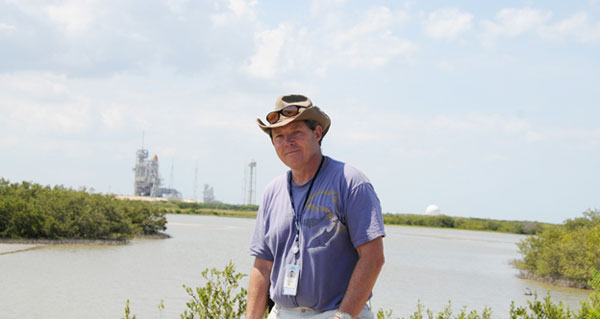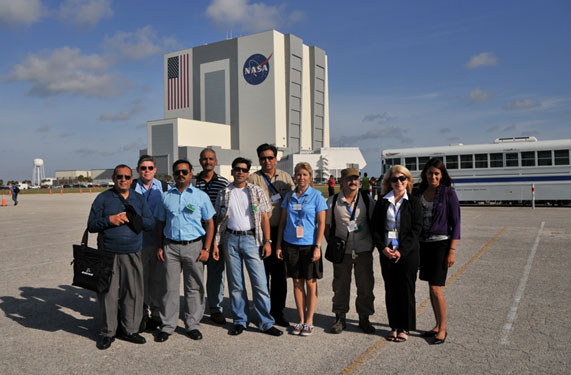|
I feel blessed to have been involved with the
Shuttle program during my career. I've seen countless
launches and landings, was escorted to the pad
and up the gantry to peer inside a shuttle cockpit,
touched the heat tiles on the shuttle's belly
during refurb in the Orbital Processing Facility
(OPF), and worked with several astronauts and
became their friends.
This connection began in 1984. I was enlisted
by CNN to be the new cable network's Florida/Caribbean
correspondent. Not only did this Canadian happily
shed his winter gear to flee south to the land
of palm trees, he also learned that covering shuttle
launches was part of the deal. "What a bonanza!"
I thought. Of course, there was some drudgery
enduring long drives to the Kennedy Space Center
(KSC) from Miami, seedy coastal motels, early
morning wake-up calls, traffic jams of tourists
and space workers, and a CNN trailer that bore
early signs of the decay and waning interest to
come for the space program.
But these launches, the world's ultimate sound-and-light
show, were spectacular. How they instantly transformed
night into day and the nocturnal croaks of KSC's
resident frogs into the longest boom of rolling
thunder I'd ever heard! These were my new country's
welcome gifts. Yet as grateful and enthusiastic
as I was in my early days, after time I succumbed
to some boredom. NASA's repeated success began
to look cookie-cutter, which was a great achievement
by the space agency but the bane of a journalist.
Even the American public showed signs of becoming
blasé, because they didn't squawk when
editors shifted shuttle stories to the inside
back pages.

Then came the Challenger tragedy on January 28,
1986.
Challenger may be the only launch I missed in
person in two-and-a-half years on the space beat.
That morning around nine, I was in a far window
seat aboard an Eastern Airlines flight leaving
Orlando for Miami. I was carrying video and interviews
that would become the story of the terrible freeze
that descended on Florida the previous night.
My crew and I spent much of it in some orange
groves, maintaining a vigil with the entire state
to gauge what damage would be inflicted on the
valuable Florida orange crop. I knew the freeze
might also delay Challenger's launch over on the
coast. But in a quirk of fate and timing, as my
plane took off Challenger lifted off at the precise
same moment about 50 miles due east. Looking across
the aisle out the portside window, I caught sight
of it with its spectacular tell-tale flame and
smoke plume. Relieved and thrilled by this airborne
view of a launch, I watched until Challenger climbed
out of sight and then settled back in my seat
for the rest of the flight. A minute or two passed
when suddenly I heard someone mutter "Challenger
just exploded". A passenger was listening
to a transistor radio on the other side of the
cabin. Instantly a chorus of "What? Are you
kidding" rose around him.
But as I jumped and turned to the far window,
I already saw pieces of Challenger's wreckage
falling back through the atmosphere. At first
I thought they might be the solid rocket boosters
making their routine return to the ocean after
separation. But the pieces were trailing smoke,
something I didn't recall seeing before. I wondered
if this was vapor generated as they fell through
the unusually cold air over Florida. But hope
gave way to tragedy: Challenger and its crew were
gone just 73 seconds after liftoff. The plane's
flight attendants politely declined my anxious
request to return to Orlando, no doubt humored
by a brash but very earnest young reporter who
thought CNN had that kind of pull. So I fidgeted
mightily for the 45 minute trip to Miami, where
I got my crew on the first flight back.
We were embarking on an historic story: the
first loss of a US space shuttle and its crew
and a space program screeching to a halt in disarray
and confusion.
I recall President Ronald Reagan's soothing remarks
that night. "They have slipped the surly
bonds of earth", he told a pained nation.
But the explosion continued to be replayed on
TV, and the memory of the astronauts, including
teacher Christa McAuliffe, weighed heavily. I
anchored CNN's coverage of the memorial service,
and then settled in to report the post-mortem
of the accident by a blue-ribbon commission appointed
by the president. Eventually the commissioners
pinpointed the cause as the O-rings seals in the
external tanks.
The freeze that attacked Florida's orange crop
that night also froze the O-rings that should
have sealed segments of the shuttle's solid rocket
boosters. The rings never did regain their warmth
and resiliency by launch time, and in their shrunken
state failed to contain the searing flames which
escaped during liftoff, igniting the external
fuel tank and exploding the shuttle. How could
it have happened? Suddenly, there was a serious
loss of confidence within NASA, and plenty of
painful soul-searching. In time, the space agency
did recover its mojo, but it grew cautious, professing
never to again allow launch deadlines to prevail
over safety.
I went on to do other things at CNN, including
covering shuttle launches from an anchor chair
in Atlanta instead of the NASA Press Site in Florida.
Yet fate returned me to the space program. At
the end of 2001, I decided to leave the CNN and
later took a position with The Boeing Company
as Director of Communications for its operations
at the KSC. Boeing was NASA's largest contractor,
the builder of all the shuttles and the prime
contractor on the International Space Station.
.

Four months after my return to Florida, on February
1, 2003, I was standing by the railing of my hotel
accommodations in Port Canaveral pointing a pair
of binoculars north across the horizon over KSC,
searching for signs of the returning Shuttle Columbia.
Counting down the seconds to its scheduled landing
time, I knew if Columbia was to show herself during
her glide to the KSC runway, it would be soon.
Off in the distance were two speeding planes
- chase planes, I assumed, in the post 9-11 security
atmosphere. But I heard no sonic boom normally
announcing a shuttle's return through the atmosphere,
and the seconds continued ticking away until they
past zero. Still no sign of Columbia. I went back
into my room and turned on the news. Not only
had Columbia not landed, but I learned no one
in NASA could pinpoint its whereabouts.
Instantly, I realized something was dreadfully
wrong. "You don't just lose track of a shuttle,"
I thought. "Unless ...." Then came those
awful images of Columbia's breakup in the skies
over Texas and a second tragedy settling in over
the US shuttle program.
I was shaken to think that as a reporter 16 years
earlier I was involved in the loss of Challenger,
and now as an aerospace executive I was witnessing
a similar tragedy. Pending an official investigation,
all shuttle launches were again put on hold as
was construction of the International Space Station
(ISS). I quickly dressed and raced out to the
KSC Press Site to help bolster the small NASA
Press Office as it awaited the incoming wave of
my former media colleagues.
In May 2010, as the shuttle program was winding
down, I escorted a contingent of India's defense
reporters across the United States to see firsthand
some of the great Boeing products, and we stopped
at the Kennedy Space Center.
The purpose was to highlight Boeing's role in
NASA's space program and maybe, maybe, see a launch.
As anyone who's done this can tell you, timing
a shuttle launch is like trying to hit a bullet
with a bullet. There's always some delay or another.
But not this time. Atlantis was on the pad ready
for a trip to the ISS and my Indian friends had
brought the luck of the Hindu god Ganesh with
them. Atlantis lifted off on the first attempt
in a spectacular liftoff on a beautiful sunny
day. This became the highlight of their trip.
These reporters had a dream come true, seeing
a launch in person, and they were awed.
Doubtless, Atlantis' final mission, successful
and inspiring as it was, held extra personal meaning
for them, as it does for me. Atlantis has always
been my favorite orbiter. I don't know why. Maybe
it's just the name I like. It seems to convey
hope that one day what's lost will be found. The
same could be said for America's space program.
Without a doubt there will be a tomorrow for space
exploration. The question is when? And by whom?
At this writing, there is arguably more fervent
interest in human space travel in India and China
than in the US. The United States is broke and
bogged down in a financial crisis, two wars and
a vacuum of political consensus. It may take an
Indian or Chinese or even Russian "Sputnik
moment" to refocus American attention on
the allure of space and rekindle a desire to "go
where no man has gone before".
Or maybe a gold discovery in the hills of meteorites
or an inexhaustible supply of fuel on the Moon.
We'll have to wait and see. The US still has the
technology and the undoubtedly the history to
lead this charge. But at the moment, it doesn't
appear to have the will.
Nonetheless, as the US Shuttle program flamed
out, the last Shuttle mission also ignited hopes
for a new vision for space missions.
|